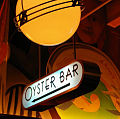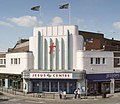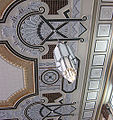Art Deco


Art Deco was a popular international design movement from 1925 until 1939, affecting the decorative arts such as architecture, interior design, and industrial design, as well as the visual arts such as fashion, painting, the graphic arts and film. in sense this movement was an amalgam of many different styles and movements of the early 20th century, including Neoclassical, Constructivism, Cubism, Modernism, Bauhaus, Art Nouveau, and Futurism. Its popularity peaked in Europe during the Roaring Twenties[1] and continued strongly in the United States through the 1930s.[2] Although many design movements have political or philosophical roots or intentions, Art Deco was purely decorative. At the time, this style was seen as elegant, functional, and modern.
History
After the Universal Exposition of 1900, various French artists formed an informal collective known as, La Société des artistes décorateurs (the society of the decorator artists). Founders included Hector Guimard, Eugène Grasset, Raoul Lachenal, Paul Follot, Maurice Dufrene, and Emile Decour. These artists heavily influenced the principles of Art Deco as a whole. This society's purpose was to demonstrate French decorative art's leading position and evolution internationally. They organized the 1925 Exposition Internationale des Arts Décoratifs et Industriels Modernes (International Exposition of Modern Industrial and Decorative Art) in Paris, which would feature French art and business interests. The terms Style Moderne and Art Deco both derive from the exposition's title, though Art Deco was not widely used until popularized by art historian Bevis Hillier's 1968 book Art Deco of the 20s and 30s.[3].
In the summer of 1969, Hillier conceived organizing an exhibition called Art Deco at the Minneapolis Institute of Arts, which took place from July to September 1971. After this event, interest in Art Deco peaked with the publication of his 1971 book The World of Art Deco, a record of the exhibition.[4]
Sources and attributes
The structure of Art Deco is based on mathematical geometric shapes. It was widely considered to be an eclectic form of elegant and stylish modernism, being influenced by a variety of sources. Among them were the so-called "primitive" arts of Africa, Ancient Egypt[5], and Aztec Mexico, as well as machine-age[6] or streamline technology such as modern aviation, electric lighting, the radio, the ocean liner and the skyscraper. It is in Streamline Moderne styles that this technology fully manifests itself and, although it is not antithetical to Art Deco, it is now considered to be a separate architectural style.[7]
Art Deco design influences were expressed in fractionated, crystalline, faceted forms of decorative Cubism and Futurism, in Fauvism's palette.[8] Other popular themes in Art Deco were trapezoidal, zigzagged, geometric, and jumbled shapes, which can be seen in many early pieces. Two great examples of these themes and styles are in Detroit, Michigan: the Fisher Building and the Guardian Building.[9]
Corresponding to these influences, Art Deco is characterized by use of materials such as aluminium, stainless steel, lacquer, inlaid wood, sharkskin (shagreen), and zebraskin. The bold use of stepped forms and sweeping curves (unlike the sinuous, natural curves of the Art Nouveau), chevron patterns, and the sunburst motif are typical of Art Deco. Some of these motifs were ubiquitous — for example, sunburst motifs were used in such varied contexts as ladies' shoes, radiator grilles, the auditorium of the Radio City Music Hall, and the spire of the Chrysler Building.
Art Deco was an opulent style, and its lavishness is attributed to reaction to the forced austerity imposed by World War I. Its rich, festive character fitted it for "modern" contexts, including the Golden Gate Bridge, interiors of cinema theaters (a prime example being the Paramount Theater in Oakland, California) and ocean liners such as the Île de France, the Queen Mary, and Normandie. Art Deco was employed extensively throughout America's train stations in the 1930s[10], designed to reflect the modernity and efficiency of the train. The first art-deco train station in the United States was the Union Station in Omaha, Nebraska.[11] [12] The unveiling of streamlined trains paralleled the construction of the art deco stations.


A parallel movement called Streamline Moderne, or simply Streamline, followed close behind. Streamline was influenced by the modern aerodynamic designs emerging from advancing technologies in aviation, ballistics, and other fields requiring high velocity. The attractive shapes resulting from scientifically applied aerodynamic principles were enthusiastically adopted within Art Deco, applying streamlining techniques to other useful objects in everyday life, such as the automobile. Although the Chrysler Airflow design of 1933 was commercially unsuccessful, it provided the lead for more conservatively designed pseudo-streamlined vehicles. These "streamlined" forms began to be used even for mundane and static objects such as pencil sharpeners and refrigerators.
Art Deco celebrates the Machine Age through explicit use of man-made materials (particularly glass and stainless steel), symmetry, repetition, modified by Asian influences such as the use of silks and Middle Eastern designs. It was strongly adopted in the United States during the Great Depression for its practicality and simplicity, while still portraying a reminder of better times and the "American Dream".
Decorative arts
Among the decorative arts during this period, architecture and sculpture are easier to recognize than other forms of Art Deco, for they experienced the greatest popularity and with greater longevity than others, such as lacquering, glass work, and industrial design. Popular sculptors include (in alphabetical order): Rene Paul Chambellan, Marshall Fredericks, C. Paul Jennewein, Joseph Kiselewski, Lee Lawrie, and Paul Manship.
Architects of this time include Albert Anis, Ernest Cormier, Banister Flight Fletcher, Bruce Goff, Charles Holden, Raymond Hood, Ely Jacques Kahn, Edwin Lutyens, William van Alen, Wirt C. Rowland, Giles Gilbert Scott, Joseph Sunlight, Ralph Walker, Thomas Wallis, and Owen Williams.
Other forms of decorative art were very focused on elegance, dynamic design, and bright colours, while expressing practical modernity. Many popular interior designers of this period were also furniture designers. Artists like Santiago Martinez Delgado, Tamara de Lempicka, Eileen Gray, Jules Leleu, and Émile-Jacques Ruhlmann all fit into this category.
A select few industrial designers were extremely popular, such as Walter Dorwin Teague, Maurice Ascalon, and Donald Deskey. Other notable artists were Georg Jensen (silversmith), Jean Dunand (lacquer), Edgar Brandt (wrought iron), Harry Clarke (stained glass) and Cartier (clocks and jewelry).
Decline and resurgence
Art Deco slowly lost patronage in the West after reaching mass production, when it began to be derided as gaudy and presenting a false image of luxury. Eventually, the style was cut short by the austerities of World War II. In colonial countries such as India and the Philippines, it became a gateway for Modernism and continued to be used well into the 1960s. Before destruction in World War II, Manila possessed many art-deco buildings; a legacy of the American colonial past. Theatres and office buildings have been lost in the war or later demolished and abandoned for new development. A resurgence of interest in Art Deco came with graphic design in the 1980s, where its association with film noir and 1930s glamour led to its use in ads for jewelry and fashion. South Beach in Miami Beach, Florida has the largest collection of art-deco architecture remaining in North America, as well as a section of Tulsa, Oklahoma.
Appropriate to the rich diversity of sources, some of the finest surviving examples of art-deco art and architecture are found in Cuba, especially in Havana. The Bacardi Building is the best known of these; however, the style is found throughout the city of Havana and other cities of Cuba. The style is expressed in the architecture of residences, businesses, hotels, and many pieces of decorative art, furniture, and utensils in these public buildings, as well as in private homes. [13]
Another country with many examples of rich art-deco architecture is Brazil, specially in Goiânia and cities like Cipó (Bahia), Iraí (Rio Grande do Sul) or even Rio de Janeiro, especially in Copacabana. Also in the Brazilian Northeast — notably in countryside cities, such as Campina Grande in Paraiba State — there is a noticeable group of Art Deco buildings, which has been called “Sertanejo Art Deco” because of its peculiar architectural features [1]. The reason for the style being so widespread in Brazil is its coincidence with the fast growth and radical economic changes of the country during 1930-1940.
Napier, New Zealand has an almost entirely art-deco town centre, rebuilt after a devastating earthquake, and mostly left unchanged since then.
Art Deco in 1930s house design in the UK
Dwelling-house design during the 1930s in the UK was also very much influenced by Art Deco. Straight, white-rendered house frontages rising to flat roofs, sharply geometric door surrounds, Egyptian motifs, tall windows as well as convex curved metal corner windows or even round bull's-eye windows (reminiscent of ocean-liner design), all were characteristic of that period [14][15] However, during double-glazing transformations in the late twentieth century, many of the original art deco window features were lost and replaced by less distinctive styles.
The 1930s was the period during which most building of homes specifically for sale took place in the UK. Despite loss of some classic art-deco features from remodelling in subsequent decades, the large number of houses remaining from the period ensures that many fine examples of art-deco housing can still be viewed.
Of particular note in the typical '1930s semi' are sunrise-symbol-motif doors, garden gates and garages as well as the infamous 'suntrap' window (featuring a distinct one-sided curve) and the linear form of the famous 'critall' window. There are features such as monochrome wall and floor tiling and bakelite door-knobs in simple geometric designs, sometimes with deco-flourished fingerplates or escutcheons.
Fine examples of luxurious art-deco homes are now vested in organisations such as English Heritage and The National Trust in the UK. Both organisations seek to maintain and restore historic homes and facilitate paid public access. A particularly beautiful example is Eltham Palace, built in 1936 by Stephen and Virginia Courtauld, close to the ruins of Henry VIII's boyhood home in London. It features a large circular reception room with a glass roof, beautifully impressive bathroom, bedrooms and dining rooms and all of the original furnishings and features, including a house-wide radio system and an arterial vacuum-cleaning system.
Contemporary applications

Although Art Deco fell out of vogue in the 1940s, it has had rebirths over subsequent decades. Its designs frequently appear in modern architecture when a "classic retro" look is sought.
In Long Beach, California, much of the recent city development has been presented in an art-deco–like, postmodern style. Similarly, Downtown Disney in Anaheim, California has an art-deco–themed section. A section of the planned community of Ladera Ranch, California, has a shopping center themed to Art Deco.
Similarly in Santa Ana, California, new development has looked to replicate and complement the historical art-deco structures already there.
In Singapore, the Parkview Square building, completed in 2002, is built in an art-deco style and includes an art-deco-styled lobby.
Much of pre-war Shanghai had a distinct art-deco style. Today, some residents are attempting to save that architecture.
Gallery
-
"The Musician", oil painting on canvas by Tamara de Lempicka, 1929.
-
Eaton's Ninth Floor Restaurant, Montreal. Protected but mothballed.
-
"Prometheus," by Paul Manship, 1933, Rockefeller Center, NY.
-
Interior of Shaw's Oyster Bar, Chicago.
-
Walter Dorwin Teague's "Beau Brownie" camera for Eastman Kodak.
-
Statue of Cristo Redentor (Christ the Redeemer) in Rio de Janeiro, Brazil, the largest art-deco object in world, built 1922-1931.
-
Buffalo City Hall in Buffalo, NY, was built in 1931.
-
The Bank of America Building, Providence, Rhode Island, completed 1928.
-
The Griffith Observatory in Los Angeles, California, compeletd 1935.
-
The Coliseu do Porto concert hall in Oporto, Portugal, built between 1937 and 1941.
-
Buffalo Central Terminal in Buffalo, NY, built in 1929.
-
Former "Eden" Theatre in Lisbon, Portugal, built in 1937.
-
The Guardian Building, in Detroit, Michigan, 1929.
-
Interior of the Guardian Building in Detroit, 1929.
-
Mural for the Century of Progress Exposition, Chicago, 1933.
-
Kansas City Power and Light Building, Kansas City, Missouri, completed 1931.
-
Delano, National hotel fronts on Collins Ave. - Miami Beach.
-
Marine Building, Burrard Street portal, 2006. Vancouver, BC
-
Tower Theater in Sacramento, California, built in 1938.[16]
-
The Observation Bar, a forward-facing lounge on RMS Queen Mary.
-
Jesus Centre in Northampton, UK, based on the former Savoy cinema, built in Streamline Moderne style in 1936.
-
Interior drawing, Eaton's College Street department store, Toronto, Canada.
-
The Supreme Court of Canada in Ottawa, which was built in 1946.
-
1931 Women's Smoking Room at the Paramount Theatre, Oakland.
-
Louisiana State Capitol in Baton Rouge, LA, built between 1930 and 1932.
-
Université de Montréal building.
-
Oregon State Capitol, Salem, Oregon, 1938.
-
Senate House at the University of London built 1932-1937
-
Minneapolis,Midtown Exchange, built 1927-1928.
-
Amsterdam,Tuschinski Theatre, built 1921.
-
Lincoln Bank Tower, Fort Wayne, Indiana, built in 1930.
-
Milano, a fountain in Central Station.
-
T&P Station (1931) lamp and ceiling detail in Fort Worth, Texas
References
- ^ Kanne-Kruike. Art Deco
- ^ Peter Hart. How Art Deco Came To Be. University Times, Volume 36, Number 4, October 9 2003. University of Pittsburgh.
- ^ Hillier B Art Deco of the 20s and 30s (Studio Vista/Dutton picturebacks, 1968) ISBN: 9780289277881
- ^ Hillier, Bevis The World of Art Deco (E.P. Dutton & Co Inc, New York, 1971) ISBN 9780525482383 ISBN 0525482385
- ^ http://www.vintageperiods.com/artdeco.php Primitive arts
- ^ http://www.vam.ac.uk/nal/guides/art_deco/index.html Machine Age
- ^ http://www.decopix.com/New%20Site/Pages/Directory%20Pages/Intro.html Streamline Moderne
- ^ http://char.txa.cornell.edu/art/decart/artdeco/artdeco.htm Cubism, etc.
- ^ Savage, Rebecca Binno and Greg Kowalski (2004). Art Deco in Detroit (Images of America). Arcadia. ISBN 0-7385-3228-2.
- ^ (nd) Art Deco Train Stations. Retrieved 7/16/07.
- ^ Johnson, C. (2001) Union Pacific and Omaha Union Station:A History pf Union Pacific Railroad Passenger Station in Omaha, Nebraska 1866-1971. South Platte Press. pp. 24. Retrieved 7/8/07.
- ^ Durham Western Heritage Museum. (nd) Museum Exterior Architecture. Retrieved 7/14/07.
- ^ Hillier, Bevis The World of Art Deco New York: Dutton) 1971 ISBN 9780525482383 ISBN 0525482385, passim.
- ^ http://www.london-footprints.co.uk/artdecobldgs.htm UK Art Deco Houses
- ^ http://www.art-deco-classics.co.uk/frinton_artdeco.php UK Art Deco Houses
- ^ Tower Theater Homepage
- ^ http://www.nps.gov/nr/travel/asheville/cit.htm National Park Service - Register of Historic Places
See also
- 1933 Chicago World's Fair Century of Progress
- 1939 New York World's Fair
- Art Deco stamps
- Aleksandra Ekster
- Corrado Parducci
- Durban Art Deco
- Fisher Building
- Francisco Salamone
- Guardian Building
- International style
- List of Art Deco architecture
- List of Art Deco buildings in Melbourne
- List of Art Deco buildings in Perth
- List of Art Deco buildings in Tasmania
- Napier, New Zealand
- Oliver Percy Bernard
- Streamline Moderne
- Vadim Meller
- Waylande Gregory
- Wirt C. Rowland
- RMS Queen Mary
Bibliography
- Applegate, Judith. Intro. by Elayne H. Varian, Art Deco (New York Finch College Museum Of Art).
- Bayer, Patricia, Art Deco Architecture Design, Decoration and Detail from the Twenties and Thirties. (London: Thames & Hudson, 1999) ISBN 0500281491, ISBN 978-0500281499.
- Benton, Charlotte (Author), Tim Benton (Author), Ghislaine Wood (Author), Oriana Baddeley (Collaborator). Art Deco: 1910-1939 (Little Brown & Co., 2003). ISBN 9780821228340 ISBN 082122834X.
- Breeze, Carla, American Art Deco: Modernistic Architecture and Regionalism (Norton, WW & Co., 2003). ISBN 0500281491; ISBN 978-0500281499.
- Gallagher, Fiona, Christie's Art Deco (Watson Guptill Publications, 2002) ISBN 1862055092.
- Hillier, Bevis The World of Art Deco (New York, E.P. Dutton & Co., Inc., 1971) ISBN 9780525482383 ISBN 0525482385.
- Ray, Gordon N.; Tansell, G. Thomas, Ed., The Art Deco Book In France. The Bibliographical Society of The University of Virginia, Charlottesville, 2005) ISBN 1883631122.
- Savage, Rebecca Binno and Greg Kowalski. Art Deco in Detroit (Images of America). (Arcadia, 2004). ISBN 0-7385-3228-2.
- Unes, Wolney. Identidade Art Deco de Goiânia. (Ateliê, 2003). ISBN 85-7480090-2.
External links
- Art Deco Brazilian Northeast
- Art Deco Ireland
- Art Deco Miami Beach
- Art Deco Montreal
- Art Deco Sydney, Australia
- Art Deco Society, Victoria, Australia
- Art Deco Society of Western Australia
- Art Deco Society of Washington
- Art Deco Society of California
- Art Deco UK
- Illustrations: The Art Deco Book in France
- Durban Deco Directory: South Africa
- Miami Beach Art Deco District
- Napier, New Zealand Art Deco Trust
- Nebraska State Capitol site
- Tulsa, Oklahoma Art Deco Heritage
- Victoria and Albert Museum Art Deco



























![Tower Theater in Sacramento, California, built in 1938.[16]](/media/wikipedia/en/thumb/a/ac/Tower_theater.jpg/120px-Tower_theater.jpg)




![Asheville Municipal Building (City Hall), Asheville, North Carolina, 1928.[17]](/media/wikipedia/commons/thumb/f/f9/Asheville_City_Hall.jpg/104px-Asheville_City_Hall.jpg)








